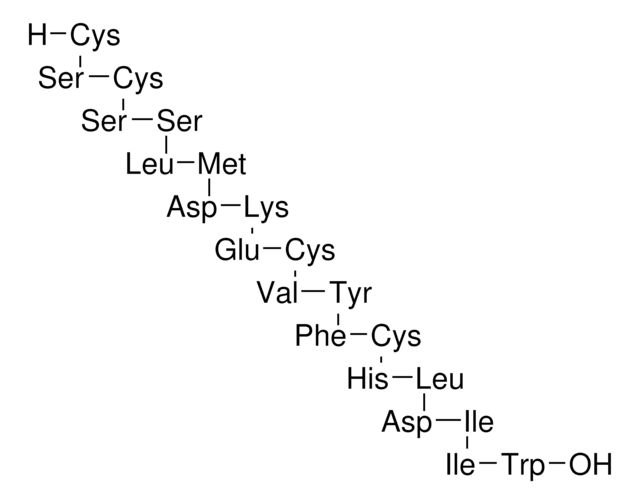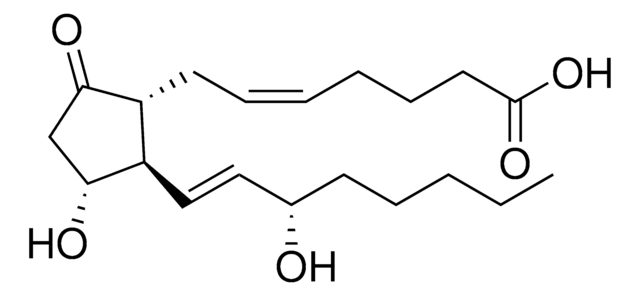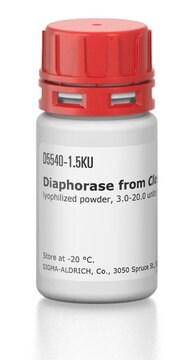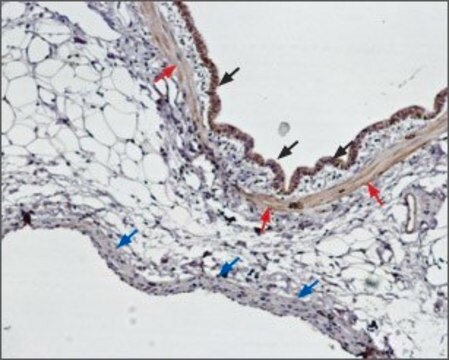E166
Monoclonal Anti-Endothelin-1 antibody produced in mouse
clone TR.ET.48.5, purified antibody
Sign Into View Organizational & Contract Pricing
All Photos(1)
About This Item
Recommended Products
biological source
mouse
Quality Level
conjugate
unconjugated
antibody form
purified antibody
antibody product type
primary antibodies
clone
TR.ET.48.5, monoclonal
species reactivity
rat, human, sheep
technique(s)
immunocytochemistry: suitable
immunohistochemistry (formalin-fixed, paraffin-embedded sections): 1:250
radioimmunoassay: 1:25,000
western blot: suitable
isotype
IgG1
UniProt accession no.
shipped in
dry ice
storage temp.
−20°C
target post-translational modification
unmodified
Gene Information
human ... EDN1(1906)
Related Categories
General description
Endothelin consists of a family of potent vasoconstrictor peptides, which include four structurally related isoforms, ET-1, ET-2, ET-3 and vasointestinal contractor (VIC, β -ET)
Specificity
The antibody shows little cross-reactivity to related peptides and no known cross-reactivity to non-related peptides.
Immunogen
endothelin-1 (ET-1) conjugated to KLH
Application
Monoclonal Anti-Endothelin-1 antibody produced in mouse is suitable for immunoblotting and immunocytochemistry.It is also suitable for radioimmunoassay (RIA) at a working dilution of 1:25,000 and for immunohistochemistry at 1:250 working dilution using formalin-fixed, paraffin-embedded tissue sections.
Biochem/physiol Actions
ET-1, a 21 amino acid peptide, is produced by vascular endothelial cells. It is a potent vasoconstrictor and plays an important role in the homeostasis of the circulatory system. It is also important in pathogenesis of cardiovascular diseases. It is also involved in contraction of airway and intestinal smooth muscle. It releases vasodilator prostaglandins and nitric oxide (NO). It also plays a role in mitogenic effects on vascular smooth muscle cells and fibroblasts, stimulation of atrial natriuretic peptide secretion from atrial cardiocytes and inhibition of renin release. ET-1 is expressed in the spinal cord and dorsal root ganglia, where it may serve as a neurotransmitter/neuromodulator.
Physical form
Solution in phosphate buffered saline, containing 0.05% sodium azide
Disclaimer
Unless otherwise stated in our catalog or other company documentation accompanying the product(s), our products are intended for research use only and are not to be used for any other purpose, which includes but is not limited to, unauthorized commercial uses, in vitro diagnostic uses, ex vivo or in vivo therapeutic uses or any type of consumption or application to humans or animals.
Not finding the right product?
Try our Product Selector Tool.
Storage Class Code
10 - Combustible liquids
WGK
nwg
Flash Point(F)
Not applicable
Flash Point(C)
Not applicable
Personal Protective Equipment
dust mask type N95 (US), Eyeshields, Gloves
Choose from one of the most recent versions:
Already Own This Product?
Find documentation for the products that you have recently purchased in the Document Library.
Hany S Abed et al.
Heart rhythm, 10(1), 90-100 (2012-10-16)
Obesity is associated with atrial fibrillation (AF); however, the mechanisms by which it induces AF are unknown. To examine the effect of progressive weight gain on the substrate for AF. Thirty sheep were studied at baseline, 4 months, and 8
I Komuro et al.
FEBS letters, 238(2), 249-252 (1988-10-10)
Recently, a potent vasoconstrictor peptide, endothelin (EDT), was isolated from vascular endothelial cells. We examined its effect on rat vascular smooth muscle cells (VSMCs). EDT induced the elevation of intracellular calcium, which was dependent on extracellular calcium and inhibited by
Y Fukuda et al.
Biochemical and biophysical research communications, 155(1), 167-172 (1988-08-30)
Using cultured neonatal rat atrial cardiocytes, we have studied the effect of synthetic porcine endothelin (pET), a novel potent vasoconstrictor isolated from endothelial cells, on the release of immunoreactive (IR) rat atrial natriuretic peptide (rANP). pET stimulated IR-rANP secretion in
Aykut Gram et al.
Reproduction (Cambridge, England), 150(5), 405-415 (2015-08-05)
Luteal development is regulated by many locally produced mediators, e.g., prostaglandins and angiogenic factors. However, the role and function of vasoactive factors in the canine corpus luteum (CL) remain largely unknown. Consequently, expression of the endothelin (ET) receptors-A and -B
Leryn J Reynolds et al.
Journal of applied physiology (Bethesda, Md. : 1985), 122(1), 38-47 (2016-11-01)
Increased endothelin-1 (ET-1) and reduced endothelial nitric oxide phosphorylation (peNOS) are hypothesized to reduce insulin-stimulated blood flow in type 2 diabetes (T2D), but studies examining these links in humans are limited. We sought to assess basal and insulin-stimulated endothelial signaling
Our team of scientists has experience in all areas of research including Life Science, Material Science, Chemical Synthesis, Chromatography, Analytical and many others.
Contact Technical Service







